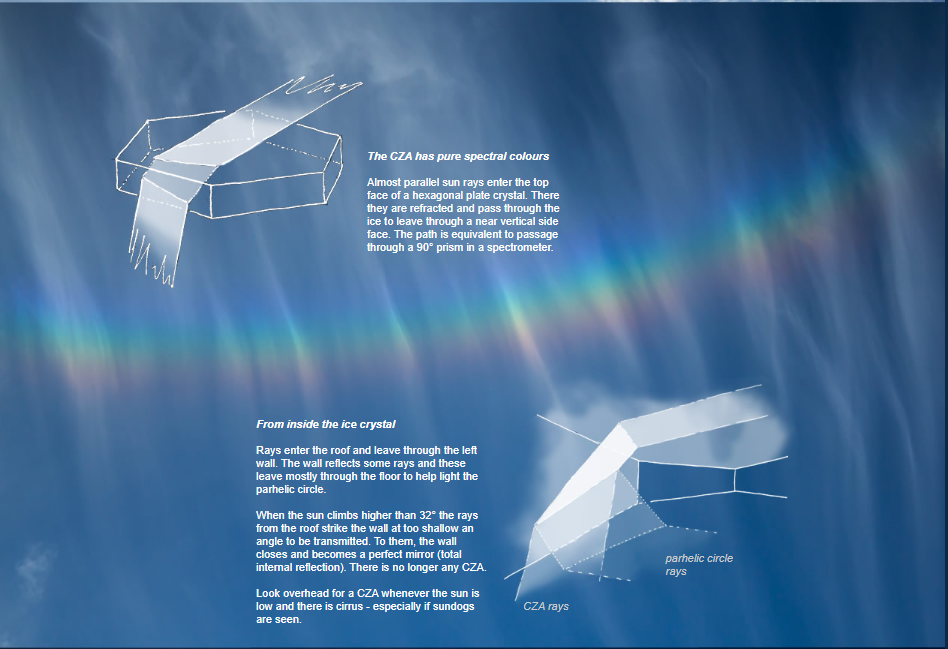Circumzenithal arc, CZA - OPOD
The Phenomenon of the Circumzenithal Arc
Have you ever looked up at the sky and seen a vibrant, colorful arc that seems to defy gravity? This optical phenomenon is known as the Circumzenithal Arc (CZA). It is one of the most stunning ice halos that can be observed in the atmosphere. Formed by the interaction of sunlight with ice crystals in cirrus clouds, the CZA appears as a halo-like arc positioned above the sun.
Understanding the Spectral Colors
What makes the CZA so captivating is its pure spectral colors. When sunlight enters the top face of a hexagonal plate ice crystal, it undergoes refraction and passes through the crystal, ultimately exiting through a near-vertical side face. This path is similar to the passage of light through a prism in a spectrometer. As a result, the CZA exhibits a full range of colors, much like a rainbow.
The Role of Ice Crystals
To fully comprehend the formation of the CZA, it is important to understand the behavior of light within ice crystals. When sunlight enters an ice crystal, it can follow various paths depending on its angle of incidence. In the case of the CZA, the rays of sunlight enter the roof of the crystal and exit through the left wall. However, some rays are reflected by the wall and leave through the floor, contributing to the illumination of the parhelic circle.
The Influence of Sun Angle
The presence of the CZA is contingent upon the angle at which sunlight strikes the ice crystals. When the sun is positioned higher than 32° in the sky, the rays from the roof of the crystal hit the wall at a shallow angle, preventing them from being transmitted. In this scenario, the wall acts as a mirror due to total internal reflection, effectively eliminating the CZA.
Optimal Viewing Conditions
If you want to catch a glimpse of the mesmerizing CZA, there are a few key factors to consider. First and foremost, the sun should be low in the sky, preferably below 32°. Additionally, the presence of cirrus clouds is crucial, as these thin, wispy clouds contain the ice crystals necessary for the formation of the CZA. Keep an eye out for sundogs as well, as they often accompany the CZA and enhance its visual impact.
Capturing the CZA in Photographs
If you're lucky enough to witness the CZA, it's a sight worth capturing. Photographing this atmospheric phenomenon can be challenging, but with the right techniques, you can document its beauty. Here are a few tips to help you capture stunning images of the CZA:
- Use a wide-angle lens to capture as much of the sky as possible.
- Adjust your camera settings to ensure proper exposure and color balance.
- Look for interesting foreground elements to add depth and context to your photographs.
- Experiment with different angles and compositions to create unique and visually appealing images.
- Consider using a polarizing filter to enhance the colors and contrast of the CZA.
The Science Behind the Beauty
While the CZA may appear magical, its formation is rooted in the principles of physics and optics. The intricate interaction between sunlight and ice crystals gives rise to this captivating atmospheric display. By understanding the behavior of light within ice crystals and the influence of sun angle, we can appreciate the science behind the beauty of the CZA.
Conclusion
The Circumzenithal Arc is a stunning optical phenomenon that adds a touch of magic to our skies. Its pure spectral colors and halo-like appearance make it a captivating sight for skywatchers around the world. By understanding the conditions necessary for its formation and employing the right techniques for photography, we can fully appreciate and document the beauty of this atmospheric marvel. So next time you spot cirrus clouds and a low sun, don't forget to look up and keep an eye out for the mesmerizing Circumzenithal Arc.

Circumzenithal Arc
The finest of all the ice halos formed here in fast moving tendrils of cirrus. Imaged in Finland by Jari Luomanen (atmospheric phenomena).
All images ©Jari Luomanen, shown with permission

The CZA has pure spectral colours
Almost parallel sun rays enter the top face of a hexagonal plate crystal. There they are refracted and pass through the ice to leave through a near vertical side face. The path is equivalent to passage through a 90° prism in a spectrometer.
From inside the ice crystal
Rays enter the roof and leave through the left wall. The wall reflects some rays and these leave mostly through the floor to help light the parhelic circle.
When the sun climbs higher than 32° the rays from the roof strike the wall at too shallow an angle to be transmitted. To them, the wall closes and becomes a perfect mirror (total internal reflection). There is no longer any CZA.
Look overhead for a CZA whenever the sun is low and there is cirrus - especially if sundogs are seen.

Note: this article has been automatically converted from the old site and may not appear as intended. You can find the original article here.
Reference Atmospheric Optics
If you use any of the definitions, information, or data presented on Atmospheric Optics, please copy the link or reference below to properly credit us as the reference source. Thank you!
-
<a href="https://atoptics.co.uk/blog/circumzenithal-arc-cza-opod/">Circumzenithal arc, CZA - OPOD</a>
-
"Circumzenithal arc, CZA - OPOD". Atmospheric Optics. Accessed on November 22, 2024. https://atoptics.co.uk/blog/circumzenithal-arc-cza-opod/.
-
"Circumzenithal arc, CZA - OPOD". Atmospheric Optics, https://atoptics.co.uk/blog/circumzenithal-arc-cza-opod/. Accessed 22 November, 2024
-
Circumzenithal arc, CZA - OPOD. Atmospheric Optics. Retrieved from https://atoptics.co.uk/blog/circumzenithal-arc-cza-opod/.